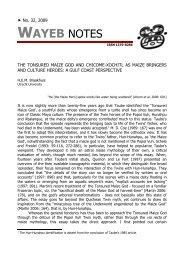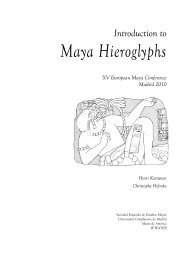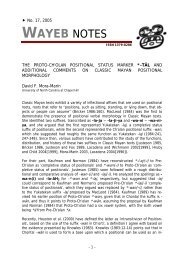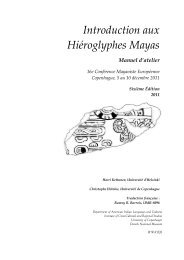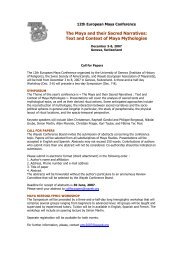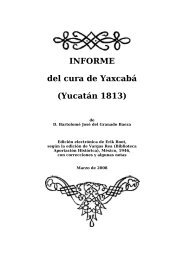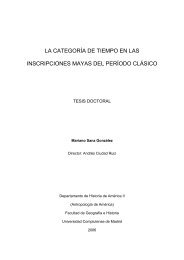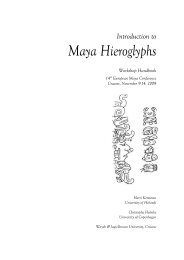The Female Title Prefix - Wayeb
The Female Title Prefix - Wayeb
The Female Title Prefix - Wayeb
You also want an ePaper? Increase the reach of your titles
YUMPU automatically turns print PDFs into web optimized ePapers that Google loves.
� No. 5, 2003<br />
WAYEB NOTES<br />
THE FEMALE TITLE PREFIX 1<br />
Elisabeth Wagner<br />
Institut für Altamerikanistik und Ethnologie (IAE)<br />
Rheinische Friedrich-Wilhelms-Universität Bonn<br />
ISSN 1379-8286<br />
It had already been proposed earlier that the female head prefixed to names and<br />
titles of women may be read IXOK (Nikolai Grube, pers. comm. 1994) instead of<br />
NA. <strong>The</strong> reason for that proposal is the spelling of the title with the logograph<br />
T1000-1003 with the syllable ki as suffix in some inscriptions (Fig. 1).<br />
Figure 1: Yaxchilan, Structure 11, Lintel 56,<br />
detail (I1-J1), nominal phrase of Lady Sak Biiyaan<br />
(from a drawing by Ian Graham, Graham<br />
1979:121)<br />
Thus the logograph representing the word for woman bearing the phonetic complement<br />
ki indicates that this word must end on –k. Words for woman are listed in Table<br />
1 below.<br />
It should be noted that if there is a final phonetic complement, there is only the syllable<br />
ki so far, bur no ko, ku, ka, or ke. Assuming vowel harmony of the final syllable<br />
to the last vowel of the word represented by T1000-1003, a reading as ixik<br />
should not be excluded – especially if one considers the fact that ixok/ixuk (vowels<br />
/o/ and /u/) only exists in Highland languages. In contrast the languages of the<br />
1 Update of an earlier version of this paper titled "Further Evidence for a Reading of the <strong>Female</strong> <strong>Title</strong><br />
<strong>Prefix</strong>" (1994)<br />
- 1 -
Eastern and Western Cholan branches have ixik (vowel /i/). Considering that the language<br />
recorded in the hieroglyphic inscriptions is assumed belonging to the Eastern<br />
Cholan and Yucatecan branches of the Mayan languages, I prefer the reading ixik for<br />
the female title prefix.<br />
Further evidence for the presented possible readings can be found in the name of<br />
Lady Ton Mul Tuun of Chichen Itza whose name is recorded on the front of the inscribed<br />
Lintel in the Akab Dzib (Fig. 2). Here the female head is prefixed by T679,<br />
the phonetic sign for the vowel /i/. This is the initial sound of the word ixik or at least<br />
ix- as it is still used as female prefix in modern Yucatec.<br />
Figure 2: Chichen Itza, Akab Dzib, inscribed lintel,<br />
front, detail (G2-H2), nominal phrase of Lady Ton<br />
Mul Tuun (from Maudslay 1989-1902,3: Pl. 19)<br />
<strong>The</strong> proof that also ix- had been used in the inscriptions one can find on Bonampak,<br />
Sculptured Stone 4 (Fig. 3). In the name of Lady K’an Tok ? appears a full phonetic<br />
spelling T679:782/1048, i-xi of the female prefix, yielding ix-.<br />
Figure 3: Bonampak, Structure 8, Sculptured<br />
Stone 4, detail (G2-H2), nominal phrase of Lady<br />
K’an Tok ? (from a drawing by Ian Graham, Corpus<br />
of Maya Hieroglyphic Inscriptions, Peabody Museum,<br />
Harvard University, Cambridge, Mass.)<br />
Language = "woman" Reference<br />
*proto-Mayan *ix England 1992: 149<br />
"<br />
CHUJ ix "<br />
Q’ANJOBAL ix "<br />
AKATEKO ix "<br />
POPTI’ ix "<br />
IXIL ixoq "<br />
K’ICHE’ ixoq "<br />
TZ’UTUJIL ixoq "<br />
KAQCHIQUEL ixök "<br />
POQOMAM ixoq "<br />
POQOMCHI’ xoq "<br />
Q’EKCHI’ ixq "<br />
MOPAN ixch’up "<br />
TOJOLAB’AL ixuk Lenkersdorf 1979,1: 133-134<br />
ITZAJ ix- Hofling and Tesucún 1997:255<br />
YUKATEK ko’lel, ix- England 1992: 149<br />
CHONTAL ix- Knowles 1984: 401-402<br />
CH’OL ixik Josserand and Hopkins 1988: 7<br />
CH’OLTI’ ixik Morán 1695<br />
CH’ORTI’ ixik Pérez Martínez et al. 1996: 76<br />
TZOTZIL antz Laughlin 1988,1: 136<br />
TZELTAL antz Slocum and Gerdel 1971: 77<br />
Table 1: Dictionary entries for "woman” in various Maya languages<br />
- 2 -
References Cited<br />
England, Nora<br />
1992 Autonomía de los Idiomas Mayas. Guatemala.<br />
Graham, Ian<br />
1979 Corpus of Maya Hieroglyphic Inscriptions, 3 (2): Yaxchilan. Cambridge,<br />
Massachussetts<br />
Hofling, Charles A., and Félix Fernando Tesucún<br />
1997 Itzaj Maya-Spanish-English Dictionary / Diccionario Itzaj-Español-Ingles. Salt<br />
Lake City.<br />
Josserand, Kathryn, and Nicholas Hopkins<br />
1988 Chol Dictionary Database. Privately published.<br />
Knowles, Susan Marie<br />
1984 A Descriptive Grammar of Chontal Maya (San Carlos Dialect). Ph D<br />
Dissertation. Tulane University, New Orleans.<br />
Laughlin, Robert M.<br />
1988 <strong>The</strong> Great Tzotzil Dictionary of Santo Domingo Zinacantán. 3 volumes.<br />
Washington, D. C.<br />
Lenkersdorf, Carlos<br />
1979 Diccionario Tojolabal – Espanol. México, D.F.<br />
Maudslay, Alfred P.<br />
1989-1902 Biologia Centrali Americana. Archaeology. London (Reprint 1974, New<br />
York).<br />
Morán, Francisco<br />
1695 Arte y Diccionario en la Lengua Cholti. Edited by Christian Prager. Unpublished<br />
manuskript.<br />
Pérez Martínez, Vitalino, Fedrico Garcia, Felipe Martinez, y Jeremias Lopez<br />
1996 Diccionario del Idioma Ch’orti’. Guatemala.<br />
Slocum, Marianna C., and Florencia L. Gerdel<br />
1971 Vocabulario Tzeltal de Bachajon. Série de Vocabularios Indígenas Mariano<br />
Silva y Aceves, 13. México, D.F.<br />
Thompson, John Eric S.<br />
1962 A Catalog of Maya Hieroglyphs. Norman.<br />
- 3 -



